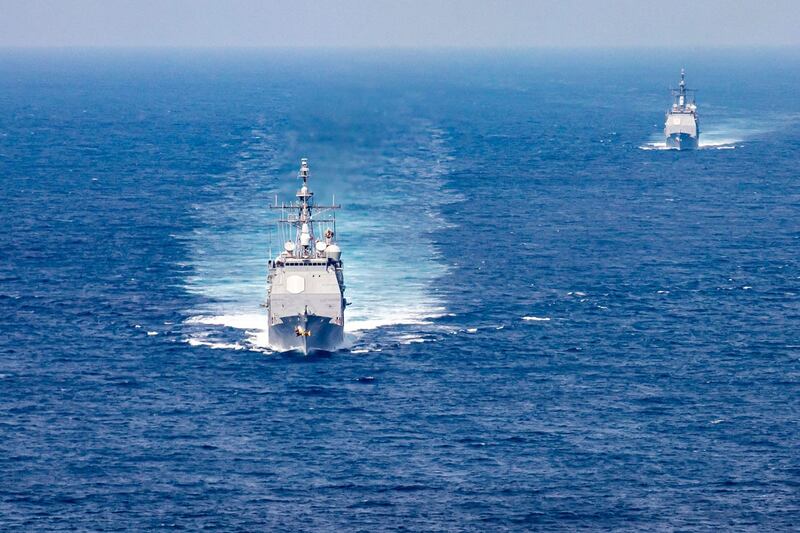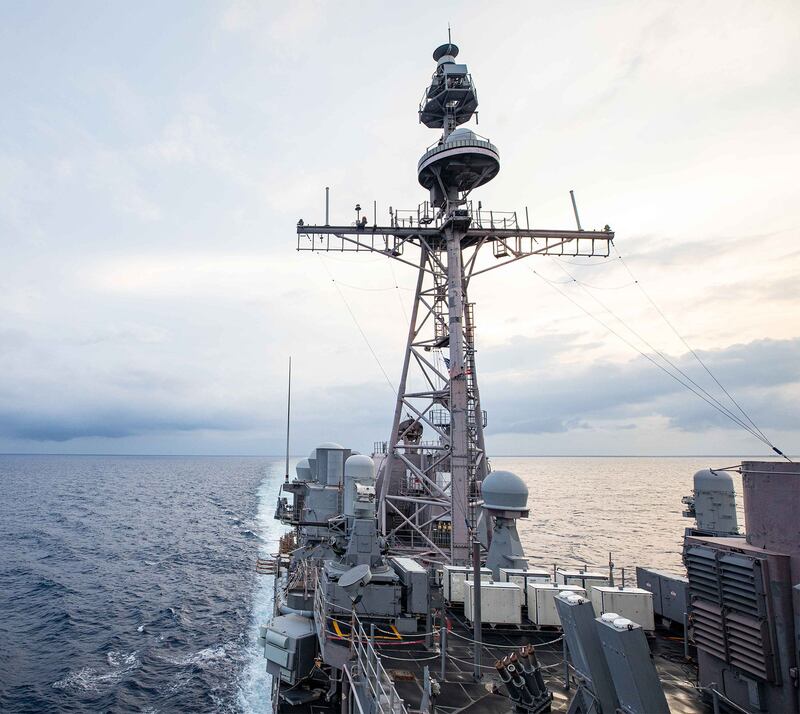Two U.S. warships made a transit through the Taiwan Strait on the same day China flew 23 aircraft into areas around Taiwan in a continuous attempt to “normalize” such activities.
In addition to Sunday's U.S. and Chinese maneuvers, China said it had conducted combat training exercises around the island last week, though the activities have not been reported in Taiwan.
Since U.S. House Speaker Nancy Pelosi’s visit to Taiwan, the Chinese People’s Liberation Army (PLA) has been conducting daily sorties into the island’s air defense identification zone (ADIZ), where foreign aircraft are tracked and identified before venturing further.
An increasing number of the aircraft have also crossed the median line dividing the Taiwan Strait, which serves as de facto maritime border between the island and China’s mainland.
Twice this month, on Aug. 18 and Aug. 27, the PLA deployed Xian H-6 strategic bombers during incursions into Taiwan, with PLA Air Force's spokesman Col. Shen Jinke saying that such deployments have become "forceful evidence of normalized patrolling."
The strategic bomber has nuclear strike capability and is capable of attacking U.S. carrier battle groups and priority targets in Asia, according to Military Today, a popular website on modern warfare.
Experts and analysts say China is trying to “salami slice their way into a new status quo” in the Strait and the region.
The China Power Project at the U.S. Center for Strategic and International Studies said in a recent report that "China is specifically seeking to erase the notion of the median line" and Beijing "also seeks to establish a new normal in which the PLA no longer respects Taiwan's claims to a separate airspace and territorial waters."
U.S. Undersecretary of Defense for policy, Colin Kahl, said during a briefing on Aug. 8 that “it's clear that Beijing is trying to create a kind of new normal, with the goal of trying to coerce Taiwan, but also frankly, to coerce the international community.”
“I think you should expect that we will continue to do Taiwan Strait transits, as we have in the past, in the coming weeks," said the undersecretary.

Routine transit
U.S. Navy’s 7th Fleet said that two of its Ticonderoga-class guided-missile cruisers, the USS Antietam and USS Chancellorsville, were “conducting a routine Taiwan Strait transitAugust 28 (local time) through waters where high seas freedoms of navigation and overflight apply in accordance with international law.”
"These ships transited through a corridor in the Strait that is beyond the territorial sea of any coastal State," the 7th Fleet said in a statement, adding that the transit "demonstrates the United States' commitment to a free and open Indo-Pacific."
Taiwan’s Defense Ministry confirmed the transit, saying the U.S. cruisers sailed from North to South of the Taiwan Strait and “the situation is normal.”
Meanwhile PLA Eastern Theater Command's spokesman Sr. Col. Shi Yi said his command "conducted security tracking and monitoring of the U.S. warships' passage in the whole course and had all movements of the two U.S. warships under control."
PLA troops “always stay on high alert and get ready to thwart any provocation,” Shi added.
Chinese observers were quick to point out that the two U.S. warships, both commissioned in the late 1980s, are near the end of their service. The U.S. Navy announced in April that it plans to retire all Ticonderoga-class cruisers by 2027.
Since the beginning of this year, American warships have conducted Taiwan Strait transits every month, apart from June when the U.S. Navy sent a P-8A Poseidon reconnaissance airplane through the Strait on June 24 instead.

Changing situation
As the “new normal” appears to have been slowly established on both sides, the PLA Eastern Theater Command said it “has in the past few days carried out joint combat-readiness security patrols and combat training exercises involving troops of multiple services and arms in the waters and airspace around the Taiwan Island.”
The information was announced on the Command's official account on WeChat on Aug. 26.
“This is a normalized military operation organized according to the changing situation in the Taiwan Straits,” it said.
Both the Taiwanese and U.S. militaries have yet to respond to these newly announced drills.
The same Eastern Theater Command was responsible for carrying out an earlier week-long military exercise around Taiwan in response to Nancy Pelosi’s visit.
Chinese leader Xi Jinping and the Communist Party of China, “having responded the way China has done so with Pelosi’s visit, have set the bar higher for themselves and future responses to perceived Taiwan and U.S. transgressions,” said Collin Koh, a Research Fellow at the S. Rajaratnam School of International Studies in Singapore.
“One possible likelihood is that hawkish factions within the Chinese political and military establishment may now have the justification to push for intensified efforts to modernize the PLA with an eye on a greater possibility of forceful reunification,” Koh said.
China considers the self-ruled democratic Taiwan one of its provinces and vows to “reunify” with the mainland, by force if necessary.
“All in all, we are likely to face heightened risks of conflict in the Taiwan Strait,” the military analyst said.
